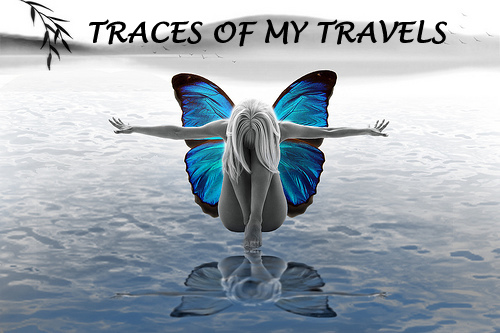This is the applied arts museum to non German speakers. The museum bills itself as one of the most important museums of applied arts in Europe, with a collection that includes furniture, interior accessories, textiles, lamps, glass, metal and ceramic objects, sculptures, antique piano instruments, books and jewellery. There was even an Andy Warhol exhibition that had one of the largest collection of posters I have seen anywhere in Europe.
 |
| Now you see me! Now you don't! |
First of all, a witty piece of woman's apparel. This was one of twenty odd pieces of weird clothing that would appeal to people with a wacky sense of humour. The body of a woman is printed on the fabric and the printing is so life-like that one almost wanted to touch it to test the reality. In the background, a video was running with a model sashaying down the catwalk in this dress. There is no doubt that this dress is provocative. My first thought was, why bare it all on print? On closer examination though, I realized how clever the whole thing was. The image on the fabric looked real, the way the garment was sewn looked real, everything looked real but it was really just an optical illusion that the onlooker sees a woman's body through a see-through dress.
 |
| Feet of clay |
This is a an illustration by Wieslaw Smetek, a Polish illustrator, graphic designer and painter working in Hamburg, who illustrates for illustrious magazines such as Time, Stern and Spiegel. His visual language is original and witty. I call this illustration Feet of Clay because it resonates with me: corporate talk of agility when making changes is more like turning an oil tanker.
Thou, O king, sawest, and behold a great image. This great image, whose brightness was excellent, stood before thee; and the form thereof was terrible.
This image's head was of fine gold, his breast and his arms of silver, his belly and his thighs of brass,
His legs of iron, his feet part of iron and part of clay (The Book of Daniel)
 |
| Bursting at the seams |
Another illustration by Smetek. This one is self explanatory. We hear about prisons bursting at the seams, hospitals bursting at the seams, refugee camps bursting at the seams etc., but seldom about EU membership bursting at the seams. Most institutions are expansionist: the more the merrier, more power makes might.
An exquisite piece of porcelain in the porcelain section. There were many beautiful pieces but for me, this one reminds me of summer and bountiful flowers. It's dainty, whimsical, and romantic. Notice the leaves threading through the flowers and the small bunch of flowers at the top acting as a grip to lift the lid. Utterly charming.
 |
| Spiegel Canteen |
This is the canteen designed by Verner Panton for Spiegel. It was orange, it was psychedelic and it made my head spin. All the designs - lamps, textiles and wall cladding were Panton's own, only the furniture had to be ordered from Knoll International according to his contracts. The specially designed mirror lighting used on walls and ceilings are unique and interesting.
 |
| Children's play area |
And finally, the children's play area located on the basement near the lockers. I was fascinated by the design, the fun chairs, the wigs, hats and garments for children (and adults) to play with. I felt like a child again and could easily have spent an hour or two there enjoying myself. In that room I found the child in me.


























































